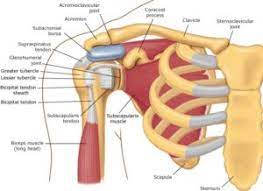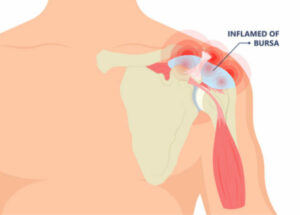If you are experiencing pain in your shoulder, it is important to seek medical attention right away. You may be suffering from bursitis, a condition that can cause significant discomfort. In this blog post, we will discuss the symptoms of bursitis in the shoulder, as well as how to treat the condition.
Contents
Defining Bursitis Shoulder

Bursitis shoulder is a condition that can cause pain and inflammation in the shoulder. The condition is caused by the inflammation of the bursa, which is a small sac of fluid that helps to cushion the joint. The condition can be caused by overuse, injury, or infection.
Symptoms
The most common symptom of shoulder bursitis is pain. You might have sudden, intense pain in your shoulder or dull, aching pain. The pain is often worse when you move your arm away from your body, lift it above your head, or lie on your affected side.
Other symptoms might include:
- Tenderness when you touch the bursa
- Swelling in your shoulder
- Redness or heat in your shoulder
- Stiffness in your shoulder
- Weakness in your arm
You should see your doctor if you have shoulder pain that doesn’t go away or gets worse. Your doctor can help you find the cause of your pain and treat it.
Causes

Bursitis is often caused by repetitive motion or overuse of the shoulder joint. This can occur from activities such as painting, gardening, or even hanging Christmas lights. Other causes include direct trauma to the area, infection, or arthritis. The various causes of bursitis shoulder are as follows:
Repetitive use of the shoulder
This is the most common cause of shoulder bursitis. Activities that involve repetitive overhead motions of the arm or a sudden impact on the shoulder can lead to inflammation of the bursa. Examples of such activities include, but are not limited to, painting, swimming, baseball, and tennis.
Injury
A direct blow to the shoulder can also cause bursitis. For instance, you might fall on your shoulder, or lift something heavy and accidentally drop it on your shoulder.
Overuse
Repeating the same motions over and over again can also lead to bursitis. This is common in sports that involve throwing, such as baseball, or in jobs that require repetitive overhead motions, such as painting or hanging drywall.
Medical conditions
Some medical conditions can increase your risk of developing bursitis. These include gout, diabetes, and rheumatoid arthritis.
Age
As you age, you become more vulnerable to developing bursitis. This is because the soft tissues in your body start to break down and wear out. This process is called atrophy, and it can cause the bursae in your shoulder to become inflamed.
Thus these are the causes and symptoms of bursitis in the shoulder. The condition is not very serious and can be treated with the help of some home remedies. But if the pain is severe then it is advisable to consult a doctor.
Treatment options
There are various treatment options which are as follows:
Rest
This is the first and most important step in the treatment of shoulder bursitis. It is important to reduce the inflammation and allow the healing process to begin. Depending on the severity of the condition, this may mean taking a few days off from work or avoiding activities that require the use of the affected arm.
Ice
Applying ice to the affected area can help to reduce inflammation and pain. It is important to do this for 20-30 minutes at a time, several times a day. For best results, use an ice pack or wrap the ice in a towel before applying it to your skin.
Heat
After the initial phase of inflammation has subsided, applying heat to the affected area can help to promote healing by increasing blood flow. This can be done with heat pads or warm baths/showers. For instance, you can fill a sock with rice, microwave it for a short time, and then apply it to the painful area.
Anti-inflammatory medication
Non-steroidal anti-inflammatory drugs (NSAIDs) such as ibuprofen can help to reduce inflammation and pain. These should only be used as directed by a doctor. For instance, if the bursitis is caused by an infection, antibiotics may be prescribed.
Physical therapy
Physical therapy can help to reduce pain and inflammation. A physical therapist can also teach exercises that will help to strengthen the muscles and prevent further injury. For example, the therapist may recommend exercises that stretch the shoulder and chest muscles. These exercises can help to improve the range of motion and reduce pain. The therapist may also recommend ice or heat therapy, electrical stimulation, or ultrasound to help reduce pain and inflammation.
Prevention
There are several things you can do to help prevent bursitis. These include warming up before physical activity, avoiding sudden movements or repetitive motions, and resting when you are feeling pain. You should also avoid activities that put undue stress on the joints, such as running or contact sports. If you have a job that requires repetitive motion, take breaks often and use proper body mechanics. Wearing supportive shoes can also help to prevent bursitis.
Steroid injections
If other measures do not provide relief, a doctor may inject steroid medication into the bursa to reduce inflammation. For the most part, shoulder bursitis is a benign condition that will resolve with time and conservative treatment. However, in some cases, the condition can lead to more serious problems.
Surgery
In rare cases, surgery may be necessary to remove the bursa or repair any damage to the tendons or ligaments. If the bursa is removed surgically, the surgeon will make a small incision and drain the fluid from the bursa sac. In some cases, the entire sac may need to be removed.
Shoulder bursitis is a condition that can cause pain and inflammation in the shoulder. It is important to seek medical treatment if you think you may have this condition. There are various treatment options available, and your doctor will be able to advise you on the best course of treatment for your particular case.
Conclusion
It may be concluded that bursitis shoulder is a condition that results when the bursa becomes inflamed. Treatment typically involves a combination of rest, ice, and physical therapy. Surgery is rarely needed. However, if the condition does not improve with conservative treatment, surgery may be necessary to remove the bursa.
Bursitis shoulder is a condition that can cause pain and stiffness in the shoulder. . If you are experiencing pain and stiffness in your shoulder, you should see a doctor get a proper diagnosis and treatment plan.
Physical Therapy help patients recover from pain. If you’re experiencing Back pain, Shoulder pain, Knee pain, Neck pain, Elbow pain, Hip pain, or Arthritis pain, a physical therapist at MantraCare can help: Book a physiotherapy session.


